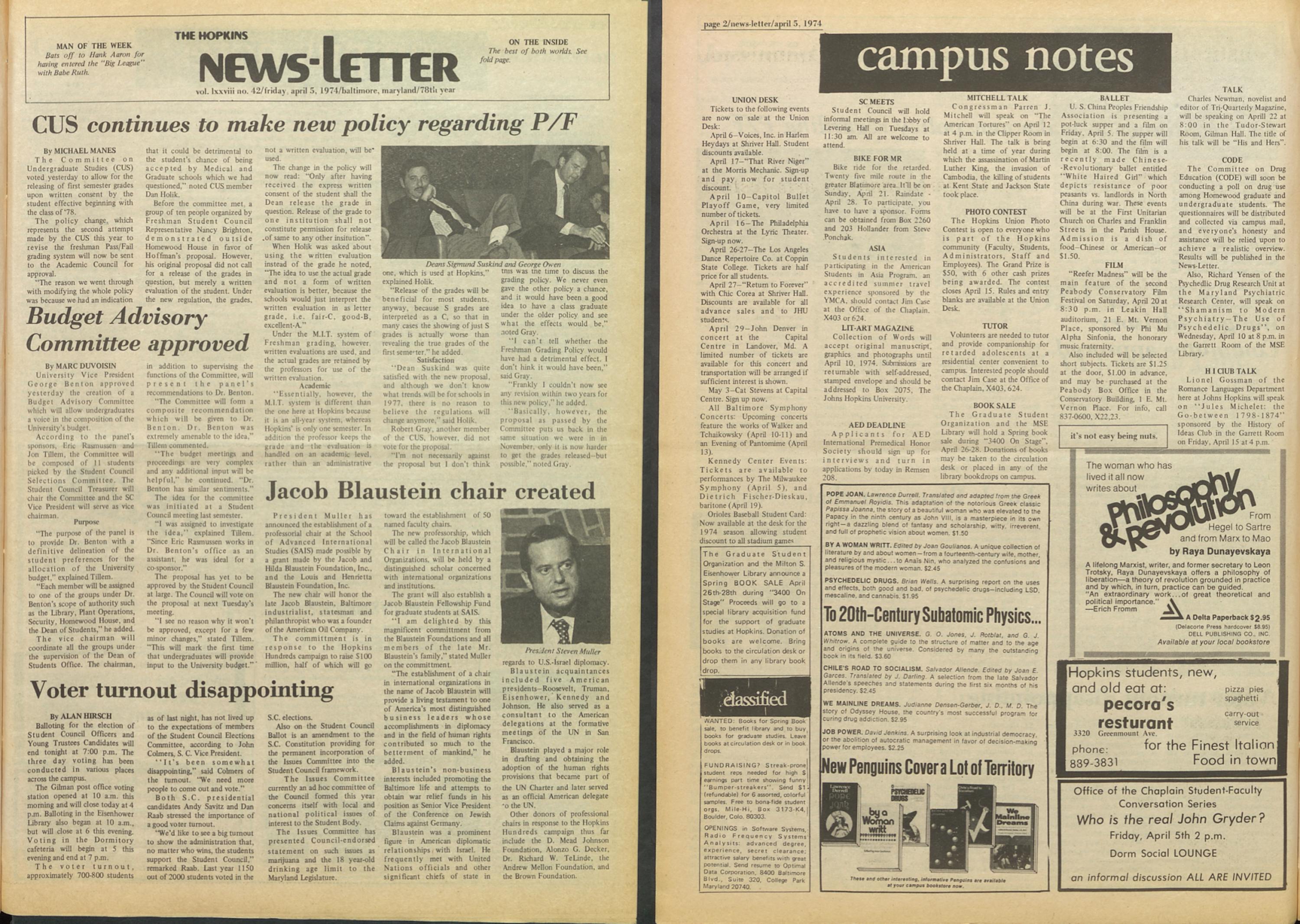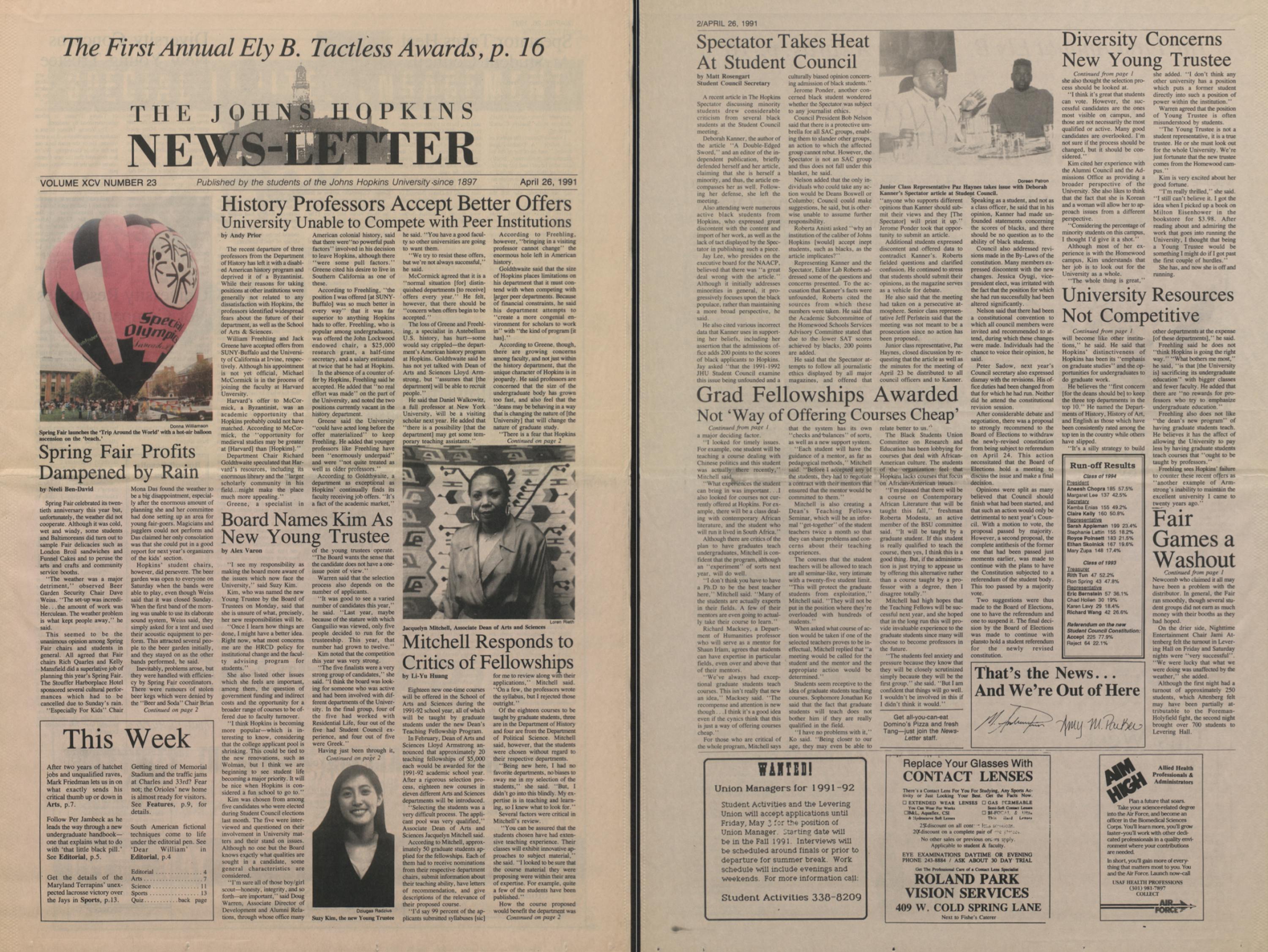In March 2020, COVID-19 forced us to switch to daily, online-only production. Yet for the nearly 125 years before the pandemic, The News-Letter was a print (or a print-first) publication.
The oldest paper in the Sheridan Libraries archive is our Oct. 14, 1897 issue. Back then, the paper was published every other week and cost 15 cents per copy or $1.50 for a yearly subscription. Some of the articles include a lecture at the School of Medicine and a piece about the institution of a College Congress at Hopkins.

This was just the fifth issue of the paper and the first of the paper’s second volume. Since then, beyond adding more staff and new sections like Opinions and Leisure, we’ve fundamentally reworked the look and goals of the paper and gone online.
So, how did we get from 1800s-era print to where we are now? To find out more about how the print edition evolved over the years, I spoke with some past News-Letter editors.
David Doupe, who graduated in 1961, was in charge of coordinating production as a Managing Editor. A small team of editors, he said, would work Wednesday nights at the Merrick Barn — where the paper lived before the Gatehouse — and ensure that by Thursday, the papers were cut up and reassembled for typeset. Doupe would then send the paper to the printers.
“I had to take a bus downtown because I wasn’t from Baltimore. They’d divide up the paper by eight or 10 men, sitting in front of these big machines. The lead type would fall into place, sit there, and they would put the paper together,” he said. “If the headlines didn’t fit or articles needed last-minute editing, it was my job to sit there and do it with them.”

Nearly a decade later in 1975, Clayton Blick was a Managing Editor. He described his role as “the production guy.” By this time, The News-Letter was located at the Gatehouse, publication had changed from once to twice a week and the paper had more space for ads and more staff to ensure a smooth production process. Blick explained that the process looked a little different from prior years due to the move and different technology.
“Editors would write their stories on typewriters. They would go off in the morning or the afternoon, interview people to get the story, come back, sit down upstairs at the table and begin typing on typewriters,” Blick said. “After dinner, I would typically show up with our typist... and begin typing [the stories] into an IBM electronic typewriter for typesetting.”
The production team would then take out the formatted print sheets and begin cutting paragraphs with a razor blade to manually align the columns on the page.

There was also a darkroom in the basement of the building for editors to develop the print photos that the printers would then attach onto the page. This was one step in the process that hadn’t changed from the ‘60s: Manual work by the students was needed to set the paper up.
Blick recalled that when the production team finished cutting up the paper it would already be well into the night.
“We were still typing articles that were coming in late, and the paper began to be put together, maybe around 8 or 9 o’clock. We all hoped, unrealistically, twice a week that we’d be done by about midnight. But that rarely happened,” he said. “The machines would break, the articles would come away — something would happen. Usually, hopefully, we got down to 2 or 3 in the morning.”
It turns out that some things never change. Machines breaking and technology short-circuiting isn’t unique to typewriters or The News-Letter’s manual era. I can remember working in the Gatehouse, trying to get a page set up and having a whole row of computers shut down when we tried to turn the heater on.
While not as egregious a problem as Blick getting his hair caught in one of the electronic typewriters, it’s a reality that production night can be a struggle. Late-night disasters could happen at any time, but it’s up to the editors to get the paper out no matter what.
Blick’s night of production wouldn’t end there.
“So it’s 3 in the morning, I’ve got a box full of master copies and photos and I drive for 45 minutes to Westminster, Md. where my buddy Larry in the other building with the printing press would then take the pages laid out in 100%, real-size,” Blick said. “On a good night, all the papers are in at 5:30 in the morning. On a bad night, it’s 7:30 in the morning.”
Driving back to Homewood Campus, Blick would maybe get a quick bite to eat after almost 12 hours of News-Letter work. He’d make sure the paper was distributed to newsstands around campus and attend a class or two in the afternoon. That would happen twice a week, which led to a very demanding schedule for all editors and those involved in production of the paper.
The most recent paper in the Sheridan Libraries archive is our April 26, 1991 issue. Unlike decades past, the image on the front page — the hot-air balloon from that year’s Spring Fair — is in full color. An article in the issue describes how flags loaned by eight foreign embassies were stolen a week before the fair began. The organizers sent a Letter to the Editor as a call for help to get them back.

In the ‘90s, the production team consisted of a Managing Editor and a Production Manager, as well as two Darkroom Managers and two Circulation Managers. The team still used the darkroom in order to develop photos for publication, and the paper was now made once a week on Wednesday nights.
Before we went online-only, we used programs like Adobe InDesign to construct all of our pages and kept our files in a Dropbox shared across all the computers in the Gatehouse — a far cry from manually cutting and sticking pages together as in Doupe and Blick’s eras.
Jacob Took, who graduated in 2020, was a Managing Editor in 2019. He and his co-editor, Alyssa Wooden, would check over pages in InDesign and rework them as needed throughout the night. They would usually leave around the time that the Editors-in-Chief and the News & Features Editors would begin checking over the front page of the paper — but their work wouldn’t end there. Bright and early every Thursday morning, Managing Editors like Took would distribute the papers around campus.
“We paid a delivery service... to bring a truck with a pallet-load full of papers to the loading dock behind Gilman Hall,” he said. “Distribution was interesting as well because we would take the old print issues to be recycled. It was an interesting metric of how much readership the print issue got, where there were more taken versus fewer.”
Of the many places Took and his predecessors distributed the paper, campus spots like Gilman Hall and other lecture halls were a constant. Blick used to distribute the paper to other University campuses on his drive back to Homewood, and in the ‘60s while Doupe was Managing Editor, the paper wouldn’t even distribute outside of campus. Took noted that he and Wooden would make sure distribution sites off-campus, like near R. House, were stocked with the latest issues.
Took recalled the issue immediately after Donald Trump was elected as president in 2016.
“That was something that people really talked about, right? Because students notice it,” he said. “When we put the print issue to good use in that way, it helps underscore a certain story or helps realize that there is some value to having something in print.”

On March 12, 2020, for our last print edition, we made sure to showcase the emptiness of campus on the front page.
This past year, a lot has changed. Daily online-only production can be demanding but a different kind of demanding from the chaos of Wednesday nights. Even without the print edition, The News-Letter has continued to bring the latest news and voices to readers, and our editors have remained a close community, even though we can’t write hilarious out-of-context quotes from half-awake editors on the walls of the Gatehouse.
We experienced something of a throwback to the print issue for our April Fools edition this year, when I went back to the Gatehouse to make a mock print first page (old Managing Editors, please cut me some slack if I forgot some of the rules).
Even without print, it is up to us, the next editors, to make sure we continue our age-old role of entertaining, engaging and informing the Hopkins and greater Baltimore communities. No matter what, that commitment remains the same.





